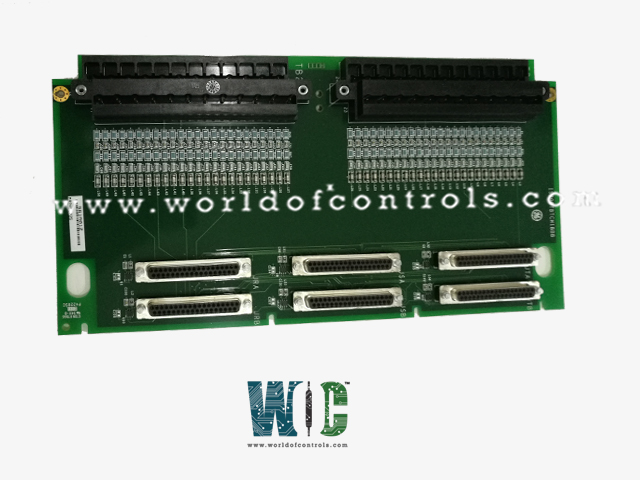SPECIFICATIONS
Part No.: IS200TBTCH1BAA
Manufacturer: General Electric
Country of Manufacture: United States of America (USA)
Size 33 cm high x 3.2 cm wide (13 in x 1.25 in)
Technology Through hole
Temperature Operating: -30 to 65oC (-22 to 149 oF)
Product Type: Thermocouple Terminal Board
Availability: In Stock
Series: Mark VIe
Functional Description
IS200TBTCH1BAA is a Thermocouple Terminal Board developed by GE. It is a part of Mark VIe control system. The terminal board is designed to accept inputs from 24 different types of thermocouples, including type E, J, K, S, or T. This wide compatibility ensures versatility in temperature sensing applications across various industries and environments. The thermocouple inputs are wired to two barrier-type blocks on the terminal board. These blocks provide a secure and reliable connection for the thermocouple wires, minimizing the risk of signal interference or loss.
Features
- Communication Interface: Communication with the I/O processor is facilitated through DC-type connectors. These connectors ensure a standardized interface for data exchange between the terminal board and the processor, simplifying integration into the control system architecture.
- Signal Integrity: The terminal board is designed to maintain signal integrity throughout the thermocouple input channels. This ensures accurate temperature measurement and monitoring, critical for process control and safety in industrial environments.
- Scalability: With the capacity to accept inputs from 24 thermocouples, the TBTC terminal board offers scalability to accommodate a large number of temperature sensing points within a control system. This scalability allows for the monitoring of temperature variations across multiple locations or processes.
- Robust Construction: The terminal board is built with durable materials and components, ensuring reliability and longevity in demanding industrial environments. Its robust construction withstands harsh operating conditions, providing consistent performance over time.
- Ease of Installation: The board is designed for easy installation, with clear labeling and intuitive wiring connections. This simplifies the setup process, reducing installation time and minimizing the risk of errors during deployment.
- Compatibility with Control Systems: The board is compatible with various control systems and architectures, allowing for seamless integration into existing infrastructure. It can interface with different types of controllers and processors, ensuring compatibility with diverse control system configurations.
Installation
- Wiring Thermocouples: Thermocouples are wired directly to two I/O terminal blocks located on the terminal board. These terminal blocks provide connections for the thermocouple wires.
- Mounting Terminal Blocks: The I/O terminal blocks are mounted on the terminal board using screws. Each block is securely held down with two screws to ensure stability during operation.
- Terminal Block Specifications: Each terminal block has 24 terminals, capable of accepting wires up to #12 AWG in size. This accommodates a wide range of thermocouple wiring configurations.
- Shield Terminal Strip: Adjacent to each terminal block, a shield terminal strip is attached to chassis ground. This strip helps to ground the thermocouple shielding, reducing electromagnetic interference.
- Mark VI System Installation: For Mark VI systems, cabling is routed from the terminal board's J-type connectors to the I/O processors located in the VME rack. These cables facilitate communication between the thermocouple inputs and the control system.
- Mark VIe System Installation: In Mark VIe systems, I/O packs are utilized instead of direct cabling. These I/O packs plug into the J-type connectors on the terminal board. The number of cables or I/O packs required depends on the level of redundancy needed for the system.
- Redundancy Considerations: The number of cables or I/O packs used in Mark VIe systems may vary based on the redundancy requirements of the application. Redundant connections ensure system reliability and fault tolerance.
- Cable Management: Proper cable management techniques should be employed to organize and secure the cables or I/O packs, minimizing the risk of damage or interference with other components.
The WOC team is always available to help you with your Mark VIe requirements. For more information, please contact WOC.
Frequently Asked Questions
What is IS200TBTCH1BAA?
It is a thermocouple terminal board developed by GE under the Mark VIe series.
What are CJ signals and how are they utilized?
CJ signals refer to cold junction compensation signals used in thermocouple temperature measurement systems. These signals are essential for compensating for temperature variations at the cold junction reference point where the thermocouple wires connect to the measurement circuitry. The CJ signals are typically averaged to provide a more accurate compensation value.
How are acceptable limits configured for CJ signals?
Acceptable limits for CJ signals are configured based on the specific application requirements and temperature measurement conditions. These limits define the acceptable range within which the CJ signals should operate. If a CJ signal exceeds these limits, a logic signal is set to indicate a potential error or out-of-spec condition.
What is the impact of CJ compensation error on thermocouple readings?
CJ compensation plays a critical role in ensuring the accuracy of thermocouple temperature measurements. Even a small error in CJ compensation can directly translate to an error in the thermocouple reading. For example, a 1 oF error in CJ compensation will result in a corresponding 1oF error in the measured temperature reading.
